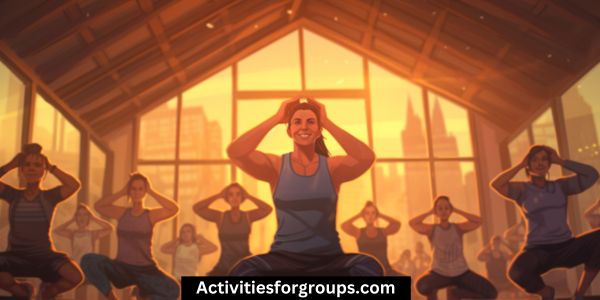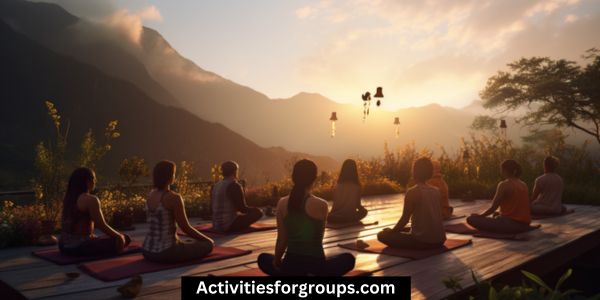Are you looking to join a group yoga session? You’re in luck! There are many types of yoga to choose from, each with its own benefits.
Hatha, Vinyasa, Yin, Hot, and Restorative are some of the most popular varieties taught in group settings.

Learn about each one to decide which type of yoga is right for you!
Hatha Yoga
Though you may have heard of yoga, you may not know that Hatha yoga is one type of yoga typically taught in group settings.
Hatha yoga focuses on physical postures, breathing techniques, and meditation practices. The practice of Hatha yoga helps bring balance to the body, mind, and spirit. It’s usually the first type of yoga that people learn.
During a Hatha yoga session, some of the movements and poses may be challenging, but they can all be modified to fit the individual’s needs.
In a Hatha yoga class, participants will be taught a variety of poses and movements. There may also be an emphasis on breathwork exercises. Breathwork is an integral part of the practice and helps to increase energy and calm the body and mind.
Meditation techniques may also be included in a Hatha yoga class. These techniques help to bring awareness to the breath and to create a sense of peace and relaxation.
Vinyasa Yoga
Typically, you’ll find a few Vinyasa yoga classes in group settings. This type of yoga is based on the Yoga philosophy and follows a sequence of poses that are linked together through breath. It’s a dynamic practice that offers many physical and mental benefits.
Here are a few things you can expect during a Vinyasa yoga class:
- Strengthening your core muscles
- Improving flexibility and balance
- Building endurance and stamina
- Reducing stress and anxiety
Vinyasa yoga is a great way to get your body warmed up and ready for a deeper practice. It’s a flowing practice that encourages students to move with their breath. It focuses on the connection between breath and movement, and it works to improve strength, flexibility, and overall wellbeing. It’s also a great way to develop body awareness and to practice mindfulness.
Vinyasa yoga classes are suitable for all levels and ages, and they can help to improve physical, mental, and emotional wellbeing.
Yin Yoga

In addition to Vinyasa yoga, another type of yoga commonly found in group settings is Yin yoga. Yin yoga is a more meditative and slow-paced style of yoga.
It focuses on mindful stretching and emphasizes meditative breathing. It’s designed to help you connect with your body and release tension. The poses are held for longer durations, usually three to five minutes, allowing your body to relax into the pose. Yin yoga is gentle and relaxing, and can be a great way to unwind and find inner peace.
Yin yoga is also great for those who are just beginning their yoga journey, as it’s a low-impact practice. It’s also beneficial for those who are looking to improve flexibility, as the poses stretch the fascia and connective tissue. It can also help with stress relief, as the slow-paced practice encourages you to be mindful and present.
Yin yoga helps to balance the yin and yang energy of the body. It’s a great complement to more active forms of yoga, as it helps to create balance between the physical and mental aspects of yoga. By doing this, it helps to create a sense of balance in our lives.
Hot Yoga
After the calming practice of Yin yoga, hot yoga is another type of yoga commonly taught in group sessions. It’s a vigorous practice that offers both physical and mental benefits. Here are some of the benefits of hot yoga:
- Improved flexibility
- Reduced stress
- Improved balance and coordination
- Increased energy
Hot yoga, however, isn’t without its challenges. Due to the intense heat and humidity, it can be difficult for beginners to adjust to the environment. Furthermore, if not practiced with proper form and alignment, it can lead to injury. It’s important to stay hydrated and move at your own pace to ensure a safe and successful practice.
The Hot Yoga Benefits outweigh the challenges if you’re willing to take the time to learn and practice correctly. With regular practice, you can expect to increase your strength, endurance, and stamina. Not only that, but it can also help you learn to control your breath, build mental clarity, and improve your concentration.
Ultimately, hot yoga is an amazing practice that can bring physical, mental, and spiritual transformation.
Restorative Yoga

Building on the benefits of hot yoga, restorative yoga is a gentle practice that helps to reduce stress, improve balance, and relax the body. It’s a slow-paced, meditative style that utilizes props such as blankets, bolsters, and straps to support the body and facilitate relaxation.
The main focus of restorative yoga is to use postures to induce relaxation, rather than to challenge the body. This is achieved by using deep, meditative breathwork combined with focused relaxation.
Restorative yoga is often the perfect complement to more active forms of yoga, such as hot yoga. It helps to deepen relaxation and stillness, and can be used to nurture the body, mind, and spirit. Many practitioners of restorative yoga find that it helps to reduce stress, improve sleep, and boost overall emotional wellbeing.
This type of yoga can also be beneficial for people with chronic illnesses, as it allows them to practice without strain or fatigue.
In a group setting, restorative yoga can be a great choice for those looking for a more relaxed experience. Classes typically include a series of supported postures and gentle stretches that are held for several minutes at a time. Through this practice, yogis can learn to settle into the postures and surrender to relaxation.
Frequently Asked Questions [FAQs]
What Is the Difference Between Group and Private Yoga Sessions?
In group sessions, the class size and qualities of the instructor experience are typically larger than private sessions. With more people, the atmosphere is different, making it more communal and energetic.
What Equipment Is Typically Required for Group Yoga Sessions?
For group yoga sessions, proper attire and equipment is essential. You’ll need a yoga mat, blocks, and straps to support the group dynamics.
What Are the Benefits of Doing Yoga in a Group Setting?
Doing yoga in a group setting can offer many benefits, such as social interaction and stress relief. You’ll be surrounded by others like you, and can gain motivation from the collective energy of the group. Plus, the sense of community can help ease anxiety and tension.
Are There Any Special Safety Considerations for Group Yoga Sessions?
When practicing yoga in a group setting, it’s important to ensure the instructor is trained to modify poses as needed. Additionally, safety considerations such as proper alignment and modifications should be addressed by the instructor.
Are There Any Discounts or Promotions Available for Group Yoga Sessions?
Yes! Many gyms and yoga studios offer cost saving promotions for group yoga sessions. Not only can you save money, but you can also enjoy the health benefits of practicing yoga with friends.
Conclusion
No matter your experience level, there’s a type of yoga to fit your needs. Whether you’re looking for a calming practice, a challenging physical workout, or something in between, group yoga classes offer a variety of options such as Hatha, Vinyasa, Yin, Hot, and Restorative Yoga.
So don’t be afraid to step out of your comfort zone and try something new – you never know what you might find!




Leave a Reply